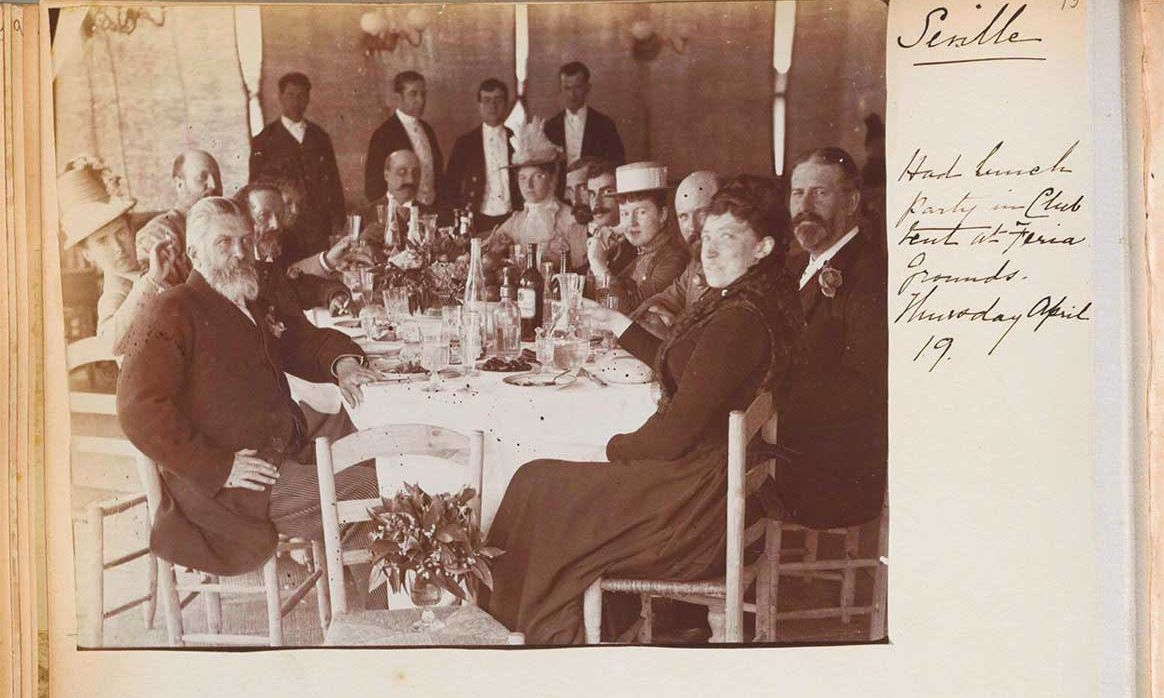Travel albums of the American collector and philanthropist Isabella Stewart Gardner (1840-1924). This page from 1888 shows images from Spain and Portugal. The albums include collected photographs, found papers, pressed botanicals and annotations
Courtesy Isabella Stewart Gardner Museum, Boston
Isabella Stewart Gardner (1840-1924) made short work of directing the building and arrangement of her now world-renowned museum-home in Boston, Massachusetts. Work began on Fenway Court (as the Isabella Stewart Gardner Museum was originally known) in 1899, the year after the death of her husband Jack, and the building was opened to the public in 1903. Before revealing this overwhelming assemblage of paintings, sculpture, decorative arts and architectural fragments, its creator had, however, undertaken a long apprenticeship in global art history.
For around 30 years, Gardner travelled ambitiously, starting in 1867 in hope of recovering her health following the death of her infant son and ending only with the loss of her husband. The Gardners toured all over Europe, as far as St Petersburg, up and down the Nile in 1875, and across Japan, China and India in 1883-84. They visited, reckoning by today’s political borders, some 39 countries. She was indeed one of a new generation of grand tourists who reset far wider the boundaries of such cultural expeditions, able to take advantage of colonial infrastructure and officialdom, but also ready to see connections between cultures that the colonial mindset fixed in hygienic silos.
Among the most intimate items in her museum today are Gardner’s 28 travel albums, which are surveyed over the introduction and five essays in this luxurious publication. The book is edited by the Isabella Stewart Gardner Museum curator Diana Greenwald and the Minneapolis Institute of Art curator Casey Riley, and accompanies an exhibition of the albums at the Gardner (until 21 May). It is oversize, with examples of pages from the albums reproduced a little smaller than their actual dimensions and within hefty margins in a design that was, perhaps, necessarily on the brutal side in order to marshal the bewildering range of visual material.
The albums are made up primarily of tourist photographs, sold at the hotels, museums and historical sites visited by the Gardners. To these Isabella added the dates of her arrivals and departures, along with inscriptions she had noted, local proverbs and the kind of heraldic badges of states and cities that backpackers used to collect. Maps, landscapes and buildings in their larger contexts were evidently of much less interest to her, and, as David Odo, a research curator at Harvard Art Museums, notes in his essay here on the Japanese material, “the personal seems to be largely missing”.
There are photographs of national costumes in large quantities, and examples of the human “types” beloved of 19th-century anthropologists and postcard publishers. But the albums, the visual tone of which was remarkably consistent over the years, are very clearly about extraordinary or beautiful things, for even the buildings become objets d’art for Gardner. Next to an image of the Anup Talao pavilion in India, she writes that it struck her as “the most gigantic of jewel cases”. If her personality is not immediately obvious in the albums, we gradually infer it through her ostensibly passive eye slowly turning the world into a pictorial museum, destined eventually to be distilled into the three-dimensional Gardner Museum.
The essays in Fellow Wanderer are largely concerned with fleshing out the photographic contexts of the albums, for together they represent, after all, the most important example of this modern medium in the Gardner Museum’s collections (all the albums can be studied in detail on the museum’s website). These experts show that we cannot see the albums as being in any straightforward sense records of a collector’s reconnaissance missions. Gardner’s fabulous acquisitions only really start to flow after her inheritance in 1891, when most of her wanderjahre were already behind her. The encyclopaedic imagery of the albums does nevertheless suggest some new perspectives for the museum as we see it today. For example, Jaipur is now proposed as being, alongside the more obvious Venice, an inspiration for the building’s showpiece courtyard.
An image from China in 1883
Courtesy Isabella Stewart Gardner Museum, Boston
It is striking that the angry old debates about Orientalism have been superseded here by anxieties about race and difference within the US itself. Gardner is largely forgiven, with caveats, for being a privileged white globetrotter. But in 1881 she travelled from Chicago by train to the Pueblo lands in the southwestern states, becoming part of the touristification of the communities there. These images are flagged with “A Note on Harmful Content” following a short but punchy text by Jaclyn Roessel, a curator and consultant known for bringing Indigenous perspectives to museums. The book, and its account of Gardner’s world tours, ends with an uncomfortable homecoming.
• Diana Seave Greenwald and Casey Riley (eds) with contributions by Pujan Gandhi, Madeleine Haddon, David Odo, Jaclyn Roessel and Stephanie Tung, Fellow Wanderer: Isabella Stewart Gardner’s Travel Albums, Isabella Stewart Gardner Museum/Princeton University Press, 244pp, 200 colour illustrations, $55/£45 (hb), published 4 April 2023
• Nicholas Tromans is the author of The Private Lives of Pictures: Art at Home in Britain, 1800-1940 (Reaktion 2022)

